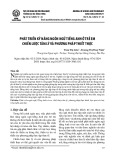
JSLHU
JOURNAL OF SCIENCE
OF LAC HONG UNIVERSITY
ISSN: 2525 - 2186
Tạp chí Khoa học Lạc Hồng, 2024, 19, 112-119
112
JSLHU, Issue 19, December 2024
THÚC ĐẨY SỰ THAM GIA TRONG LỚP HỌC TIẾNG ANH - KHÁM
PHÁ TÁC ĐỘNG CỦA CÔNG CỤ CLASSDOJO
Đoàn Trần Hoàng Dung, Nguyễn Thị Phụng Nhi
Trường Đại học Lạc Hồng, số 10 Huỳnh Văn Nghệ, Bửu Long, Biên Hòa, Đồng Nai
Tác giả liên hệ: dungdoan@lhu.edu.vn
THÔNG TIN BÀI BÁO
TÓM TẮT
Nghiên cứu định tính này tập trung vào tác động của ClassDojo đối với sự tham gia
của 100 sinh viên Khoa Ngôn ngữ Anh (EFL) tại Đại học Lạc Hồng, Việt Nam,
thông qua cuộc phỏng vấn bán cấu trúc và quan sát lớp học. Các phát hiện cho thấy
ClassDojo có ảnh hưởng đa chiều đối với sự tham gia của sinh viên. Việc áp dụng
các yếu tố trò chơi điện tử như điểm, huy hiệu và bảng xếp hạng giúp tăng thêm sự
thú vị và cảm giác thành tựu, khuyến khích sự tham gia và cải thiện chuyên cần. Tuy
nhiên, mức độ hiệu quả có sự khác biệt. Cùng với đó, nghiên cứu cũng phát hiện ra
những thách thức tiềm ẩn, chẳng hạn như việc phụ thuộc quá nhiều vào ứng dụng
trò chơi điện tử có thể làm giảm đi động lực nội tại của việc học ngôn ngữ. Nghiên
cứu này cung cấp hiểu biết sâu sắc và giá trị cho người dạy ngoại ngữ khi cố gắng
sử dụng ClassDojo để tăng cường sự tương tác. Các đề xuất được đưa ra nhằm tối
ưu hóa tính năng của nó để củng cố tích cực, tích hợp các hoạt động với mục tiêu
học tập và giải quyết nhu cầu cụ thể của từng sinh viên. Nghiên cứu nhấn mạnh tiềm
năng của việc áp dụng trò chơi điện tử để tăng cường sự tham gia, nhưng cũng nhấn
mạnh tầm quan trọng của việc tích hợp nó vào một phương pháp dạy học ngôn ngữ
ở mức độ rộng lớn hơn nhằm thúc đẩy động lực nội tại cho việc tiếp thu ngôn ngữ.
Ngày nhận:
19/8/2024
Ngày hoàn thiện:
1/10/2024
Ngày chấp nhận:
11/11/2024
Ngày đăng:
8/12/2024
TỪ KHÓA
ClassDojo;
Sự tham gia;
Động lực;
Nghiên cứu định tính;
Người học tiếng Anh.
FOSTERING ENGAGEMENT IN EFL CLASSROOMS - EXPLORING
THE INFLUENCE OF CLASSDOJO
Doan Tran Hoang Dung, Nguyen Thi Phung Nhi
Lac Hong University, No. 10 Huynh Van Nghe Str., Buu Long Ward, Bien Hoa, Dong Nai, Vietnam
Corresponding Author: dungdoan@lhu.edu.vn
ARTICLE INFO
ABSTRACT
Received:
Aug 19th, 2024
This qualitative study investigates the impact of ClassDojo, a gamified classroom
management app, on student engagement among 100 English as a Foreign
Language (EFL) learners at Lac Hong University, Vietnam. Utilizing semi-
structured interviews and classroom observations, the research explores how
students experience ClassDojo and how it influences their attendance,
participation, and overall motivation in the English language learning environment.
The findings reveal the multifaceted influence of ClassDojo on student
engagement. The gamification elements, including points, badges, and leader
boards, contribute to increased enjoyment and a sense of achievement, potentially
fostering intrinsic motivation. Furthermore, the app seems to encourage
participation and improve attendance frequency. However, the effectiveness varies
across students, with some potentially relying more heavily on extrinsic motivators
provided by ClassDojo. The qualitative exploration also uncovers potential
challenges, such as over-reliance on gamification potentially overshadowing
intrinsic motivation for language learning. This study offers valuable insights for
educators seeking to leverage ClassDojo to enhance engagement in EFL
classrooms. Recommendations for optimizing features for positive reinforcement,
integrating activities with learning objectives, and addressing individual student
needs are presented. The research underscores the potential of gamification to
enhance engagement but emphasizes the importance of integrating it within a
broader language learning pedagogy that fosters intrinsic motivation for language
acquisition.
Revised:
Oct 1st, 2024
Accepted:
Nov 11st, 2024
Published:
Dec 8th, 2024
KEYWORDS
ClassDojo;
Classroom engagement;
Motivation;
Qualitative research;
EFL learners.
Avaiable online at: https://js.lhu.edu.vn/index.php/lachong

























